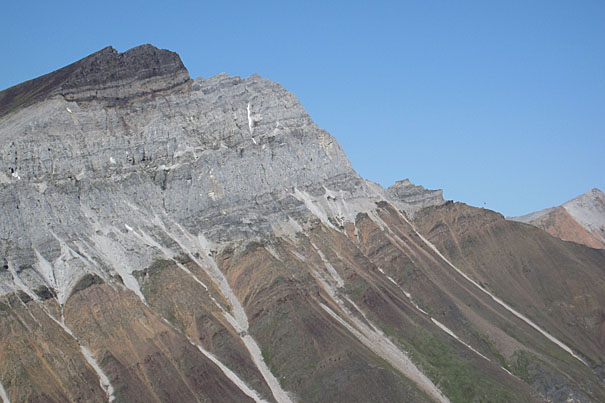
In this photo from Canada’s Yukon Territory, an iron-rich layer of 716.5-million-year-old glacial deposits (maroon in color) is seen atop an older carbonate reef (gray in color) that formed in the tropics.
Francis A. Macdonald/Harvard University
Signs of ‘snowball Earth’
Research suggests global glaciation 716.5 million years ago
Geologists have found evidence that sea ice extended to the equator 716.5 million years ago, bringing new precision to a “snowball Earth” event long suspected of occurring around that time.
Led by scientists at Harvard University, the team reports on its work in the journal Science (released March 4). The new findings — based on an analysis of ancient tropical rocks in remote northwestern Canada — bolster the theory that the planet has, at times in the past, been covered with ice at all latitudes.
“This is the first time that the Sturtian glaciation [the name for that ice age] has been shown to have occurred at tropical latitudes, providing direct evidence that this particular glaciation was a ‘snowball Earth’ event,” said lead author Francis A. Macdonald, an assistant professor in the Department of Earth and Planetary Sciences at Harvard. “Our data also suggests that the Sturtian glaciation lasted a minimum of 5 million years.”
The survival of eukaryotic life — organisms composed of one or more cells, each with a nucleus enclosed by a membrane — throughout this period indicates that sunlight and surface water remained available somewhere on the surface of Earth. The earliest animals arose at roughly the same time, following a major proliferation of eukaryotes.
Even on a snowball Earth, Macdonald said, there would be temperature gradients, and it is likely that ice would be dynamic: flowing, thinning, and forming local patches of open water, providing refuge for life.
“The fossil record suggests that all of the major eukaryotic groups, with the possible exception of animals, existed before the Sturtian glaciation,” Macdonald said. “The questions that arise from this are: If a snowball Earth existed, how did these eukaryotes survive? Moreover, did the Sturtian snowball Earth stimulate evolution and the origin of animals?”
“From an evolutionary perspective,” he added, “it’s not always a bad thing for life on Earth to face severe stress.”
The rocks that Macdonald and his colleagues analyzed in Canada’s Yukon Territory showed glacial deposits and other signs of glaciation, such as striated clasts, ice-rafted debris, and deformation of soft sediments. The scientists were able to determine, based on the magnetism and composition of these rocks, that 716.5 million years ago they were located at sea level in the tropics, at about 10 degrees latitude.
“Because of the high albedo [light reflection] of ice, climate modeling has long predicted that if sea ice were ever to develop within 30 degrees latitude of the equator, the whole ocean would rapidly freeze over,” Macdonald said. “So our result implies quite strongly that ice would have been found at all latitudes during the Sturtian glaciation.”
Scientists don’t know exactly what caused this glaciation or what ended it, but Macdonald says its age of 716.5 million years closely matches the age of a large igneous province stretching more than 930 miles from Alaska to Ellesmere Island in far northeastern Canada. This coincidence could mean the glaciation was either precipitated or terminated by volcanic activity.
Macdonald’s co-authors on the Science paper are research assistant Phoebe A. Cohen; David T. Johnston, assistant professor of earth and planetary sciences; and Daniel P. Schrag, Sturgis Hooper Professor of Geology and Professor of Environmental Science and Engineering, all of Harvard. Other co-authors are Mark D. Schmitz and James L. Crowley of Boise State University; Charles F. Roots of the Geological Survey of Canada; David S. Jones of Washington University in St. Louis; Adam C. Maloof of Princeton University; and Justin V. Strauss.
The work was supported by the Polar Continental Shelf Project and the National Science Foundation’s Geobiology and Environmental Geochemistry Program.





